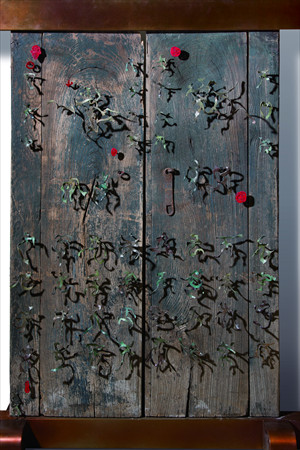 |
|
Age 2 +++++. Photo Courtesy of the 11 Gallery.
|
Shadow play has been revived countless times since the dawn of ancient China. Now comes a modern rendition of these dancing shadows, this time expressed with twisted metal sculptures inspired by calligraphy.
In his latest solo exhibition Shadow Dancing, San Francisco-based sculptor Jin Feng playfully molds small metal figures into shapes that evoke 3D brushstrokes sticking out from a solid screen. From a distance these figures appear as Chinese handwriting. However, closer inspection reveals that these are not metal reproductions of real Chinese characters, but rather are faux-characters that have sprung from the artist's imagination.
Another interesting feature, each upraised "character" casts a shadow on background panels. This play of light and shadow offers an artistic inkblot test that holds different meaning for each new observer.
The exhibit opened on November 2 at the 11 Gallery in Beijing. Among the gallery-goers was Liu Shasha, a recent Peking University graduate. Walking around the gallery, she tilted her head and tried to decipher the mystery script before her. Red metal seals stuck out from the artworks, but that too was part of the illusion. In the end, Liu thought she recognized, in a way, ancient characters from a poem written during China's Spring and Autumn Period (770 BC-476 BC).
Other gallery-goers imagined the shadowy shapes to be dancers waving their hips, or acrobats doing human pretzel contortions. Still others insisted that the stick-out figures were derived from the ancient pictograms carved into oracle bones.
Recommend:
